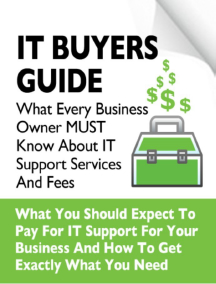Managed Services -
Substantial Benefits!
• Increased Employee Productivity - We improve the overall health, speed, and performance of your network while virtually eliminating downtime.
• Decreased and Predictable IT Spending - We charge a flat rate for monitoring and proactive maintenance while
preventing costly problems.
• Full-time Support at Part-time Prices - We also provide our clients with prompt IT support for day-to-day needs, but at a fraction of what it would cost to hire an in-house IT person.
• Tailored Packages - Every business is unique. We offer a
variety of cloud services, traditional on-premises services,
and hybrid solutions depending on what is best for your business.
• Peace of Mind - We monitor our clients’ backups, anti-virus, and security so you can focus on
running your business.
Learn more
|
|
 Provided courtesy of Ed Bensinger, Provided courtesy of Ed Bensinger,
President, Bensinger Consulting.
“As a business owner, you don’t have time to waste on technical and operational issues. That’s where we shine! Call us and put an end to your IT problems finally and forever!”
|
|
 Cloud Computing: Cloud Computing:
The Good, Bad & Ugly
|
| When a network of Internet of Things (IoT) gadgets like routers, DVR machines and closed-circuit TVs can take down hardened, well-provisioned Internet giants like Twitter, Spotify and Amazon - as happened last October - you’ve got to think twice before moving your data to the cloud.
Yes, a move to the cloud can yield big payoffs in terms of cost savings, increased efficiency, greater flexibility,
collaboration for your workforce and more. Yet there is a dark side.
It would be naive to think otherwise. Your choices about whether and how to use cloud technology in your network merits serious consideration.
So, just what is “the cloud”? Instead of constantly buying new equipment and software, cloud computing allows you to pay for just what you need.
Just as with a utility company, you get software and storage on a monthly basis, with no long term contracts. |
|
Chances are, most of the software you now use is cloud-based. You simply access it on a pay-as you-go basis. Similarly, you can store data in the
cloud, where it can be easily accessed when you need it. This reduces the need to buy and manage your own backup gear and software, thus reducing overhead.Yet, as with any major decision, it’s critical to be aware of both the benefits and pitfalls of putting your company’s data in the cloud.The Pros There are three major advantages offered by cloud computing:1. Flexibility. Scaling up or down can be done without major investment or leaving excess capacity idle. It also enables your entire workforce to get more done, where and when they need to.2. Collaboration. With data and software in a shared cloud environment, staff can collaborate from anywhere.
cont pg2 |
|
|
|
Get More Free Tips, Tools and Services On Our Web Site:
www.BensingerConsulting.com or call 602-362-0202
|
|
Everything from HR to accounting, and from operations to sales and customer relations, can be managed from diverse and mobile environments, giving your team greater power to collaborate effectively.
3. Disaster Recovery.
Typically, data stored in the cloud can be easily retrieved in the event of a disaster. It also augments local backup and recovery systems, adding protective redundancy.
“Keep verifiable
anti-malware software in place throughout your network at all times.”
The Cons While the cloud offers obvious benefits, it also increases your company’s potential “attack surface” for cyber-criminals. By spreading your communications and access to data beyond a safe “firewall,” your network is far more exposed to a whole bevy of security concerns. Many of them can be addressed with these three best practices:
|
|
|
1. Social Engineering Awareness. Whether you go cloud or local, the weakest link in your network is not in your equipment or software; it’s in the people who use them. Cyber-criminals are aware of this fact.
And you can count on them to
come up with an endless variety of ways to exploit it. One day it’s a phone call ostensibly from your IT department requesting sensitive data, the next it’s an e-mail that looks official but contains malicious links. Make sure your employees are aware of and trained to deal with these vulnerabilities.
2. Password Security and Activity Monitoring. Maintaining login
security is absolutely critical any time you’re in a cloud
environment. Train your staff in how to create secure passwords and implement two-factor authentication whenever possible. Take advantage of monitoring tools that can alert you to suspicious logins, unauthorized file transfers and other potentially damaging activity. |
|
|
3. Anti-Malware/Antivirus Solutions. Malicious software
allows criminals to obtain user
data, security credentials and sensitive information without
the knowledge of the user. Not
only that, some purported anti-malware software on the market is actually malware in disguise. Keep verifiable anti-malware software in place throughout your network at all times, and train your employees in how to work with it.
Free Cloud Readiness
Assessment Reveals Benefits And Pitfalls For Your Company From A Move To The Cloud
During the month of February,
we’re offering a FREE Cloud Readiness Assessment for any company with 10 or more computers and a server. We’ll conduct a complete review of your computer network, data, software and hardware and how you work. We’ll then give you helpful answers and insights about cloud computing for your business - all at no cost or obligation to you. |
|
|
|
|
|
Free Report Download:
The Business Owner’s Guide To IT Support Services And Fees.
|
|

You will learn: The 3 most common ways IT services companies charge for their services, and the pros and cons of each approach.
- A common billing model that puts ALL THE RISK on you, the customer, when buying IT services; you’ll learn what it is and why you need to avoid agreeing to it.
- Exclusions, hidden fees and other “gotcha” clauses IT companies put in their contracts that you DON’T want to agree to.
- How to make sure you know exactly what you’re getting to avoid disappointment, frustration and added costs later on that you didn’t anticipate.
Claim Your FREE Copy Today!
www.bensingerconsulting.com/buyersguide/ |
|
|
|
|
|
Bensinger Consulting specializes in IT services for Small and Medium Businesses.
• Managed IT Services
• Cloud Computing
• Network Security
• Data Backup and
Business Continuity
• Workspace as a Service
• Dropbox Type Solutions
• Hosted VoIP Solutions
• PCI and HIPA
Compliance
Call: 602.262.0202
|
|
3 Ways Leaders Build
Trust In Their Teams
|
| Warren Buffett once famously said, “It takes 20 years to build a reputation and five minutes to ruin it.” While that may be true of public perceptions held by those outside of an organization, a leader’s reputation within their company should be far more stable - as long as that person is working daily to build a reputation among team members as dependable and trustworthy, that is.
Trust is contagious. If team members are to become more honest and reliable, a leader needs to start by demonstrating those qualities. Building trust within an organization must be intentional. When leaders get it right, it boosts productivity, increases positivity and builds positive relationships throughout the company.
Here are three steps to building trust within an organization: Do What You Say.
This is the foundation. It may seem obvious, but not following words with actions is often the first mistake leaders make. Because there is not always someone holding the person in charge accountable, it can be easy for higher-ups to feel entitled to do something other than what has been promised.
Let’s face it – employees can be too intimidated to call out the boss (out loud to their face, anyway).
A leader should always be honest and reliable in their words and actions – even when it comes to things as simple as showing up to meetings and sticking to agendas. People are watching, and it matters to them. If team members feel they can’t trust someone on the small stuff, there’s no way they’ll trust their |
|
| supervisor with larger or more important things.
Ask About the Personal Things
It can be difficult to know whether someone deserves a celebration or needs help without making it a point to find out what’s going on with team members. Setting up a recurring time to ask how things are going can encourage people to share.
Some may be reticent to voice personal information at work, but there are ways to open the conversation. Ask questions like “What were your personal highs and lows over the past week?” If a team member has difficulty opening up, lead by example. Sharing a personal story first demonstrates that you have sufficient trust in your team to share their personal lows. Then team members will be more likely to follow.
Learn Together
Nothing works to build trust in a team as much as learning together does. Find opportunities to travel to a seminar, go to trade shows or even hold recurring lunch-and-learn meetings with a different leader each week. The benefits of traveling and learning together are numerous, but the most important, positive outcome just might be the deep trust that can develop through those share experiences.
Trust is essential in order to have a healthy organization - between executives, team members and among the entire staff, no matter how large or small. By being an active participant, and staying reliable and open, leaders help their teams work more efficiently and with greater passion for their work. |
|
|
|

|
| Andy Bailey can cut through organizational BS faster than a hot knife through butter, showing organizations the logjams thwarting their success and coaching them past the excuses. After all, as he tells his clients, 100% annual growth is only 2% growth every week. It’s not easy. But possible. Andy learned how to build great organizations by building a great business, which he started in college then, grew into an Inc. 500 multi-million dollar national company that he successfully sold and exited. He founded Petra to pass on to other entrepreneurs, business own-ers and leaders the principles and prac-tices he used to build his successful enterprise, which are rooted in the Rockefeller Habits methodology. |
|
|
Get More Free Tips, Tools and Services At Our Web Site:
www.BensingerConsulting.com or call 602-362-0202
|
|